- Authors

- Name
- Harrison Broadbent
- @hrrsnbbnt
Lately, I've been previewing a lot of emails.
I've been building the RailsNotesUI ActionMailer Components Library — think ActionMailer components like
Email::Button— so I needed an easy way to preview my Rails mailers.I ended up going pretty deep into previewing emails in Ruby on Rails, and I wanted to share it with you here. The short version of this article is that the
letter_openergem is OK, I love MailCatcher, and MailHog is great (but a bit overkill for me). And if you want, you can skip all this extra stuff, and just use ActionMailer's native previews.
Table of Contents
If you're sending emails from your Ruby on Rails apps, you're going to want to preview them (please do... I've seen some wonky emails).
Fortunately, there are four (!!!) great ways to do this in Rails —
- ActionMailer includes native mailer previews.
- Then there's the letter_opener gem, which is simple, but basic.
- There's also MailCatcher, my personal favourite.
- Finally there's MailHog, the most advanced of the bunch.
I've experimented with all four of these methods while I've been working on RailsNotesUI. The good news is that any of these methods will probably serve you well, but there are some subtle differences which I'll cover.
In this article, I'm going to share everything I've learned about email previewing in Rails, and I'm going to show you how to quickly preview emails in your Ruby on Rails apps, using each of these methods (mailer previews, letter_opener, MailCatcher and MailHog).
Note: All these methods assume you're using ActionMailer to deliver your emails (if you're calling
Mailer.deliver_now, you should be OK). These methods either hijack theaction_mailer.delivery_methodattribute to deliver emails to a preview inbox, or in the case of native mailer previews, just render your mailer directly.Never heard of ActionMailer? If you're interested in learning, I wrote about ActionMailer here — From API calls to ActionMailer.
Using ActionMailer's native mailer previews
Ruby on Rails has a simple, easy way of previewing your mailers, and it's where I recommend you start. Plus, this method requires no extra dependencies.
Every time you generate a mailer in your Ruby on Rails apps, ActionMailer also generates an ActionMailer::Preview for your email. You can view them in your browser, and they look a bit like this —
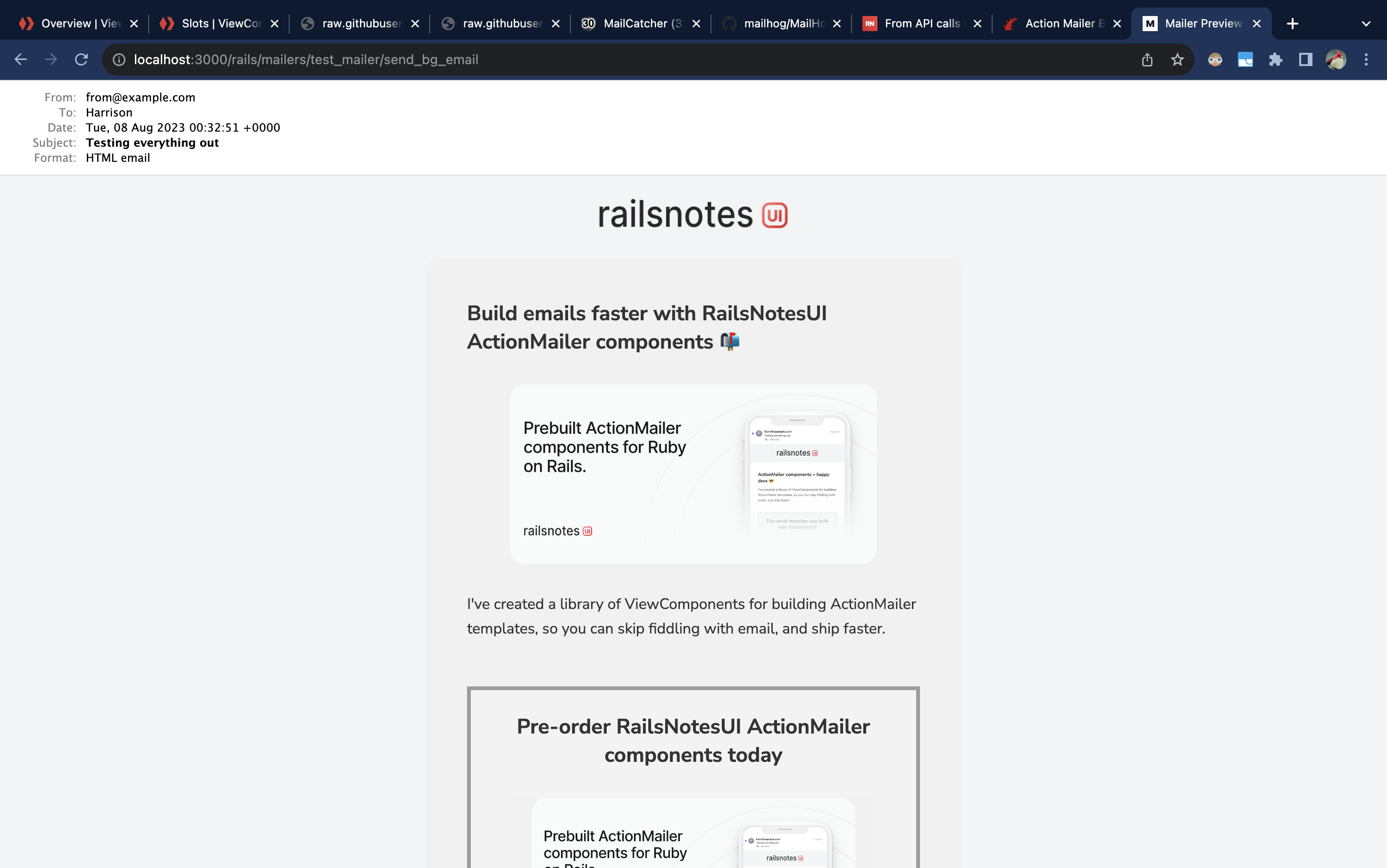
Learn more in the official ActionMailer docs
I've also created a Rails Generate Mailer Command Builder that you might find handy!
Wait what? How did Rails generate this mailer preview?
When you generate an ActionMailer mailer, Rails creates a couple of files, and one of those is the test/mailers/previews/preview.rb file —
rails g mailer test
create app/mailers/test_mailer.rb
invoke erb
create app/views/test_mailer
invoke test_unit
create test/mailers/test_mailer_test.rb
create test/mailers/previews/test_mailer_preview.rb # <<< your preview
If you open that file, you'll see something like this —
# Preview all emails at http://localhost:3000/rails/mailers/test_mailer
class TestMailerPreview < ActionMailer::Preview
end
Rails automatically generated an ActionMailer::Preview for our mailer. We just need to fill it in!
We need to add a method to TestMailerPreview which invokes the email we want to preview. To preview the TestMailer.send_bg_email email, first add a method like this —
class TestMailerPreview < ActionMailer::Preview
def test_email
TestMailer.send_bg_email
end
end
Then, we start our Rails app locally and visit the preview URL (http://localhost:3000/rails/mailers). We can see a list of all our mailer previews —

Then we can click on one of our mailer previews to see it —

That's it! This is by far the easiest way to preview emails in your Rails app — you just need to add a method to your mailers/previews files and you're set.
One handy thing about ActionMailer previews is that your email previews are responsive (for testing mobile views of your emails). You can use your browser developer tools to resize your viewport and get an idea of how your mailers will look at different sizes —
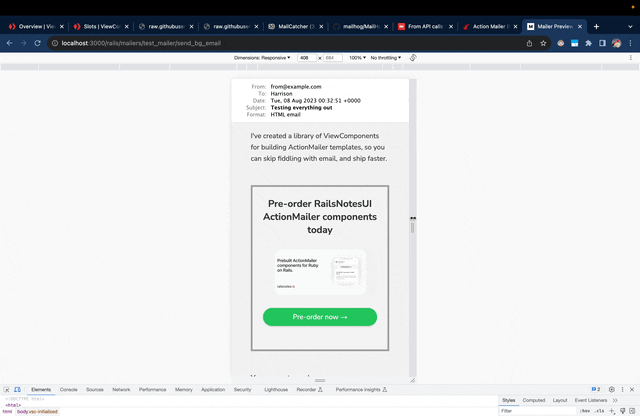
One last thing — It's important to note that unlike any of the following options, ActionMailer previews don't actually send your emails, just render them.
In practice, this shouldn't change how your emails look (since all the options in this article are browser-based, they'll all look the same on your device). It means though that ActionMailer previews won't pass through the Rails SMTP gateway (unlike with letter_opener, MailCatcher or MailHog).
Previewing emails with the letter_opener gem
The letter_opener gem is pretty basic compared to the other options in this article. It's still handy though, and easy to set up.
Here's what a letter_opener preview of an email looks like —
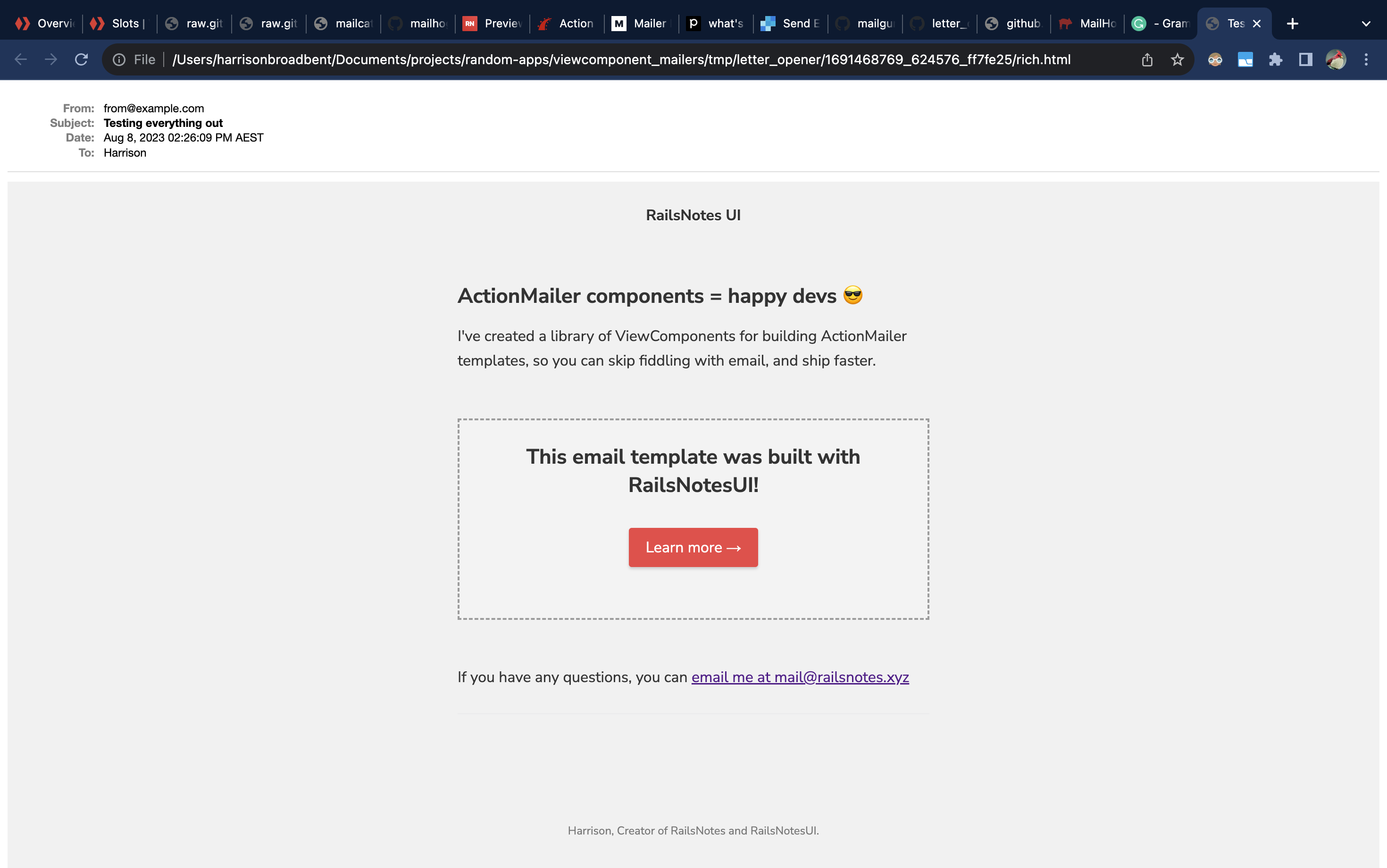
Unlike MailCatcher and MailHog (from the next sections), the letter_opener gem won't give you an inbox. It just grabs the emails you send from your Rails app, and automatically displays them in a new browser tab.
If you're testing lots of emails, the lack of inbox, plus the auto-opening in a new tab gets annoying (lots of browser tabs, hard to find old emails, etc). If you're just sending a couple of test emails though, there's nothing to worry about.
You could check out letter_opener_web for a
letter_openerpowered inbox. However, I recommend just usingMailCatcherorMailHoginstead. I don't thinkletter_opener_webis as good as the other two options.
To use letter_opener in your Rails app, first add it to your Gemfile —
gem "letter_opener", group: :development
Note: don't forget to
bundle
Next, we need to configure Rails to send emails to letter_opener. We can do that by editing config/environments/development.rb, and adding —
config.action_mailer.delivery_method = :letter_opener
config.action_mailer.perform_deliveries = true
That's it! These two lines configure ActionMailer to send emails via letter_opener. Once they're sent, letter_opener will intercept them and open them up for us in our browser.
Note: The
letter_openergem has a few configuration options, which you can learn more about at the letter_opener GitHub page. In most cases though, you won't need to touch them.
In most cases, the letter_opener gem will probably give you everything you need — a simple way to preview emails in your Rails app.
You could stop reading here, but I encourage you to continue — MailCatcher and MailHog aren't too different from letter_opener, but they have a few handy things which make them nicer to work with.
Previewing emails with MailCatcher
I like MailCatcher. It's easy to set up, it gives you a neatly organized web inbox (unlike letter_opener), and it's simpler than MailHog.
From the MailCatcher website —
Catches mail and serves it through a dream.
MailCatcher runs a super simple SMTP server which catches any message sent to it to display in a web interface. Run
mailcatcher, set your favourite app to deliver tosmtp://127.0.0.1:1025instead of your default SMTP server, then check out http://127.0.0.1:1080 to see the mail that's arrived so far.
MailCatcher does one thing well. It runs a local inbox for us, which our Rails app can send mail to, and we can view in our browser. It looks like this —
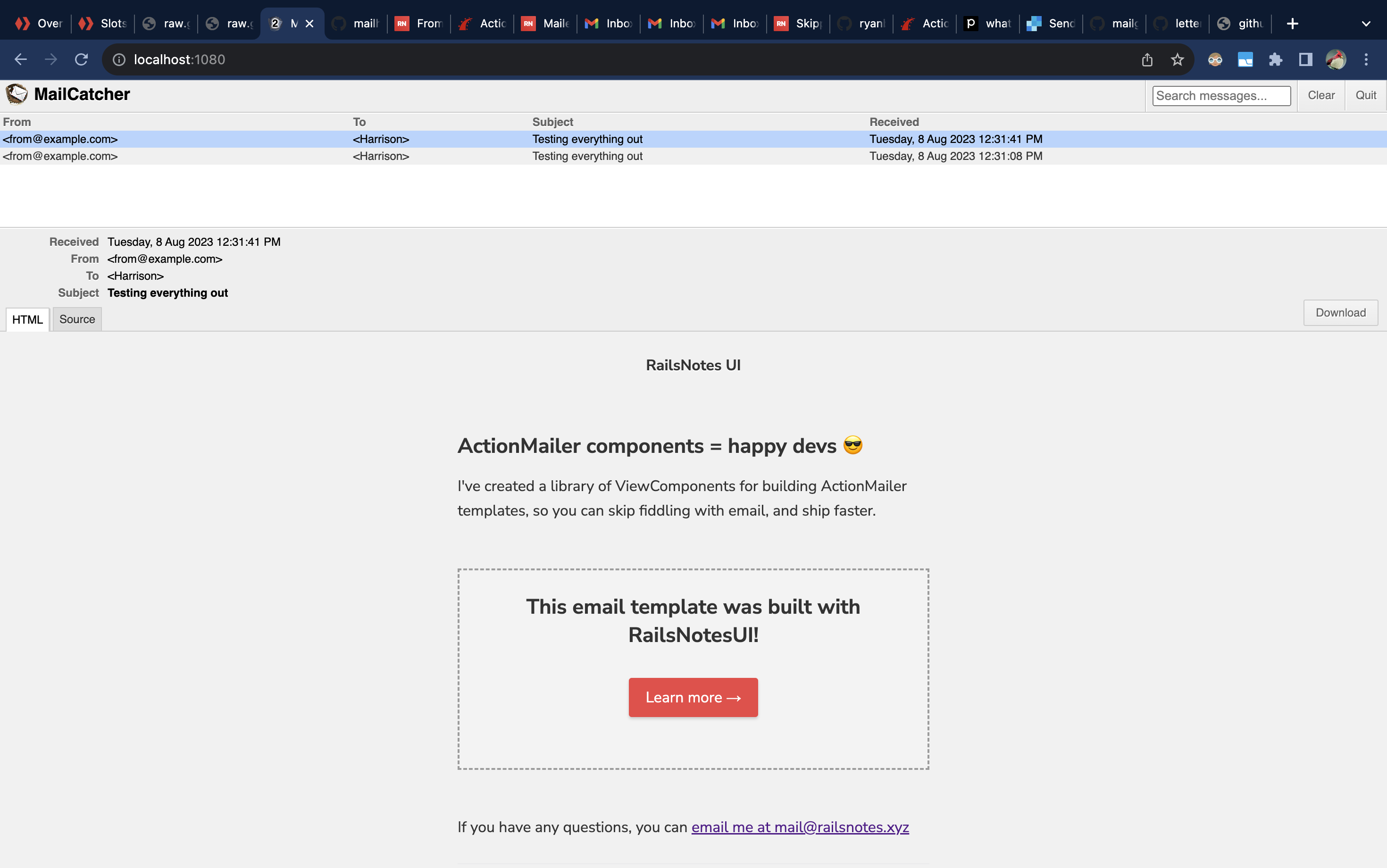
MailCatcher is also quick to set up. The MailCatcher setup instructions are easy to follow, but to repeat them here, we first install the mailcatcher gem —
gem install mailcatcher
Note: don't add
mailcatcherto yourGemfile. You want to install it system-wide.
Then start mailcatcher with —
mailcatcher
Starting MailCatcher v0.9.0
==> smtp://127.0.0.1:1025
==> http://127.0.0.1:1080
*** MailCatcher runs as a daemon by default. Go to the web interface to quit.
Running mailcatcher starts two separate servers — the first is the http: server, which we visit in our browser to preview our emails. The second is the smtp: server, which is where we want our Rails app to deliver our emails.
Note: MailCatcher runs as a daemon by default, so you don't need to keep a terminal window running.
We can adjust our Rails app to route emails to mailcatcher like so —
config.action_mailer.delivery_method = :smtp
config.action_mailer.smtp_settings = { :address => "127.0.0.1", :port => 1025 }
config.action_mailer.raise_delivery_errors = false
Now, if we visit http://127.0.0.1:1080 and send an email, it shows up in our MailCatcher inbox —

I've been using
rails runnerto send emails directly from my terminal, like this —rails runner "Mailer.invoice().deliver_now"I've written more about
rails runnerhere — Skipping the console with Rails Runner.
That's it! Again, the setup is easy, and we can also do handy things like view our email source code, and download it as a .eml file.
The only major drawback to note (that I've found) is that MailCatcher doesn't correctly reflow when we adjust our browser viewport, which makes it impossible to test responsive layouts.
You can see that if we shrink our viewport, MailCatcher also shrinks, which isn't what we want —
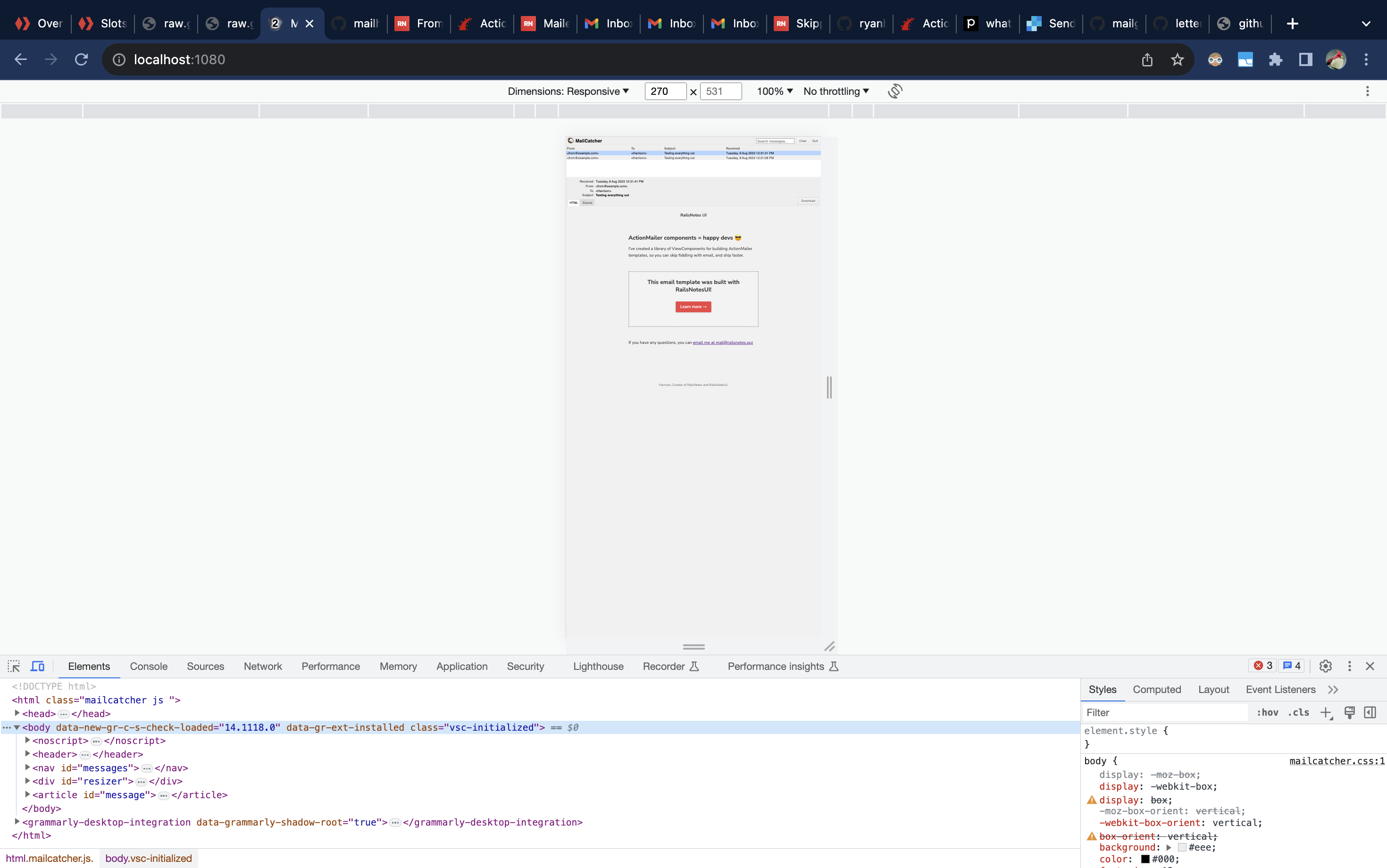
I don't think this issue is a total show-stopper, but it can be pretty annoying.
If it's an issue for you, MailHog(below) does everything that MailCatcher does, plus it correctly resizes the viewport.
Upgrading from MailCatcher to MailHog
MailHog is like MailCatcher but better. It does everything that MailCatcher does, plus it correctly responds to a resized browser viewport, and it includes a couple of handy extras (like Jim, the chaos monkey 🙉).
Getting started with MailHog is easy. On my Macbook, it's as simple as —
brew install mailhog
MailHog is designed to be a drop-in replacement for MailCatcher. If we run mailhog, you'll see that it starts running on the same SMTP port that MailCatcher did —
mailhog
2023/08/08 12:45:23 Using in-memory storage
[HTTP] Binding to address: 0.0.0.0:8025
2023/08/08 12:45:23 Serving under http://0.0.0.0:8025/
2023/08/08 12:45:23 [SMTP] Binding to address: 0.0.0.0:1025
This means that we can re-use our MailCatcher configuration with MailHog —
# this is the same config that we used for MailCatcher
# no changes needed
config.action_mailer.delivery_method = :smtp
config.action_mailer.smtp_settings = { :address => "127.0.0.1", :port => 1025 }
config.action_mailer.raise_delivery_errors = false
If we send an email from our Rails app, you'll see it appear inside our MailHog inbox —
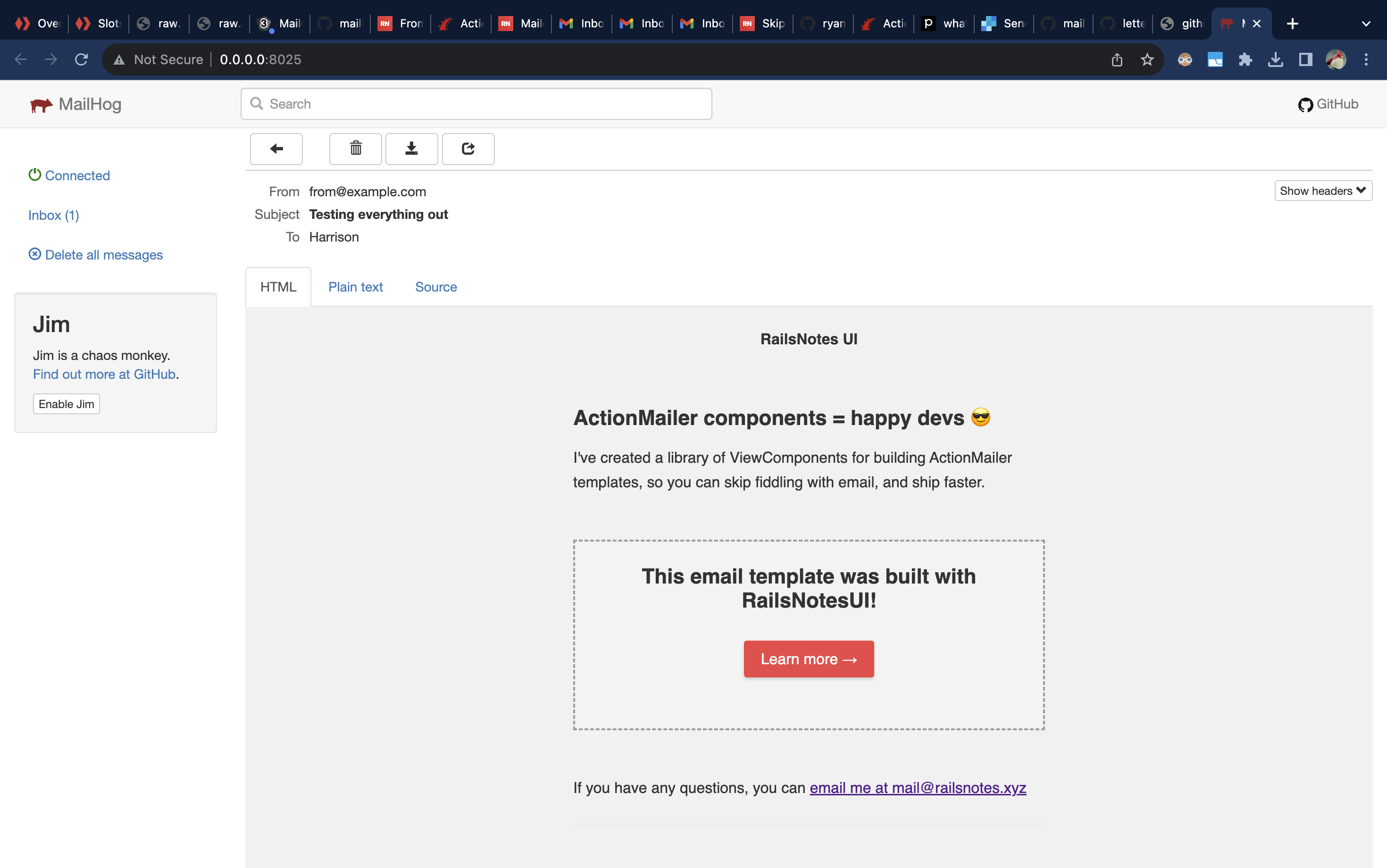
MailHog has a few handy improvements over MailCatcher, but its big feature is Jim, the chaos monkey 🙉.
Enabling Jim will configure MailHog to behave erratically when it receives emails, which can be helpful for debugging. I haven't used Jim enough to say more, but it's worth looking into if you want to test your emails more thoroughly.
Unlike MailCatcher, MailHog will also correctly resize our email preview as we adjust our browser viewport. This makes it easy to test mobile/responsive email layouts, which is a big plus.
Despite MailHog being superior to MailCatcher feature-wise, I still find myself drawn to MailCatcher. I think it's because, for me, the MailCatcher UI is simpler than MailHog. I also like how MailCatcher runs as a background daemon, whereas you need to keep MailHog alive in a terminal window.
Honestly though, MailHog and MailCatcher are similar enough that I think it's worth just picking the one you like more.
Conclusion
Thanks for reading — I hope you found this article useful! Who knew that the world of Ruby on Rails mail previewing tools could be so rich and diverse!
Whether you end up choosing letter_opener, MailCatcher, MailHog or native mailer previews, I think you'll be in good hands.
And if you're stuck. you can always do what I did, and try out all 4!